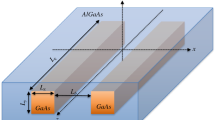Abstract
The ability to control and modulate the composition1,2,3,4, doping1,3,4,5, crystal structure6,7,8 and morphology9,10 of semiconductor nanowires during the synthesis process has allowed researchers to explore various applications of nanowires11,12,13,14,15. However, despite advances in nanowire synthesis, progress towards the ab initio design and growth of hierarchical nanostructures has been limited. Here, we demonstrate a ‘nanotectonic’ approach that provides iterative control over the nucleation and growth of nanowires, and use it to grow kinked or zigzag nanowires in which the straight sections are separated by triangular joints. Moreover, the lengths of the straight sections can be controlled and the growth direction remains coherent along the nanowire. We also grow dopant-modulated structures in which specific device functions, including p–n diodes and field-effect transistors, can be precisely localized at the kinked junctions in the nanowires.
This is a preview of subscription content, access via your institution
Access options
Subscribe to this journal
Receive 12 print issues and online access
$259.00 per year
only $21.58 per issue
Buy this article
- Purchase on Springer Link
- Instant access to full article PDF
Prices may be subject to local taxes which are calculated during checkout





Similar content being viewed by others
References
Gudiksen, M. S., Lauhon, L. J., Wang, J., Smith, D. C. & Lieber, C. M. Growth of nanowire superlattice structures for nanoscale photonics and electronics. Nature 415, 617–620 (2002).
Bjork, M. T. et al. One-dimensional heterostructures in semiconductor nanowhiskers. Appl. Phys. Lett. 80, 1058–1060 (2002).
Lauhon, L. J., Gudiksen, M. S., Wang, D. L. & Lieber, C. M. Epitaxial core–shell and core–multishell nanowire heterostructures. Nature 420, 57–61 (2002).
Qian, F., Li, Y., Gradečak, S., Wang, D. L., Barrelet, C. J. & Lieber, C. M. Gallium nitride-based nanowire radial heterostructures for nanophotonics. Nano Lett. 4, 1975–1979 (2004).
Yang, C., Zhong, Z. H. & Lieber, C. M. Encoding electronic properties by synthesis of axial modulation-doped silicon nanowires. Science 310, 1304–1307 (2005).
Algra, R. E. et al. Twinning superlattices in indium phosphide nanowires. Nature 456, 369–372 (2008).
Caroff, P. et al. Controlled polytypic and twin-plane superlattices in iii–v nanowires. Nature Nanotech 4, 50–55 (2009).
Davidson, F. M., Lee, D. C., Fanfair, D. D. & Korgel B. A. Lamellar twinning in semiconductor nanowires. J. Phys. Chem. C 111, 2929–2935 (2007).
Ross, F. M., Tersoff, J. & Reuter, M. C. Sawtooth faceting in silicon nanowires. Phys. Rev. Lett. 95, 146104 (2005).
Gao, P. X. et al. Conversion of zinc oxide nanobelts into superlattice-structured nanohelices. Science 309, 1700–1704 (2005).
Lu, W. & Lieber, C. M. Nanoelectronics from the bottom up. Nature Mater. 6, 841–850 (2007).
Sirbuly, D. J., Law, M., Yan, H. Q. & Yang, P. D. Semiconductor nanowires for subwavelength photonics integration. J. Phys. Chem. B 109, 15190–15213 (2005).
Patolsky, F., Timko, B. P., Zheng, G. & Lieber, C. M. Nanowire-based nanoelectronic devices in the life sciences. MRS Bull. 32, 142–149 (2007).
Stern, E. et al. Label-free immunodetection with CMOS-compatible semiconducting nanowires. Nature 7127, 519–522 (2007).
McAlpine, M. C., Ahmad, H., Wang, D. W. & Heath, J. R. Highly ordered nanowire arrays on plastic substrates for ultrasensitive flexible chemical sensors. Nature Mater. 6, 379–384 (2007).
Yaghi, O. M. et al. Reticular synthesis and the design of new materials. Nature 423, 705–714 (2003).
Wagner, R. S. & Ellis, W. C. Vapor–liquid–solid mechanism of single crystal growth. Appl. Phys. Lett. 4, 89–90 (1964).
Morales, A. M. & Lieber, C. M. A laser ablation method for the synthesis of crystalline semiconductor nanowires. Science 279, 208–211 (1998).
Wu, Y. et al. Controlled growth and structures of molecular-scale silicon nanowires. Nano Lett. 4, 433–436 (2004).
Lugstein, A. et al. Pressure-induced orientation control of the growth of epitaxial silicon nanowires. Nano Lett. 8, 2310–2314 (2008).
Dick, K. A. et al. The morphology of axial and branched nanowire heterostructures. Nano Lett. 7, 1817–1822 (2007).
Kodambaka, S., Tersoff, J., Reuter, M. C. & Ross, F. M. Germanium nanowire growth below the eutectic temperature. Science 316, 729–732 (2007).
Kim, B. J. et al. Kinetics of individual nucleation events observed in nanoscale vapor–liquid–solid growth. Science 322, 1070–1073 (2008).
Wacaser, B. A. et al. Preferential interface nucleation: an expansion of the VLS growth mechanism for nanowires. Adv. Mater. 21, 153–165 (2009).
Jaccodine, R. J. Surface energy of germanium and silicon. J. Electrochem. Soc. 110, 524–527 (1963).
Pan, L., Lew, K.-K., Redwing, J. M. & Dickey, E. C. Stranski–Krastanow growth of germanium on silicon nanowires. Nano Lett. 5, 1081–1085 (2005).
Acknowledgements
The authors would like to thank Y. J. Dong, X. C. Jiang and Q. Qing for help with experiments. C.M.L. acknowledges support from a National Institutes of Health Director's Pioneer Award, a McKnight Foundation Neuroscience Award and a contract from MITRE Corporation. T.J.K acknowledges support from the National Science Foundation Graduate Research Fellowship.
Author information
Authors and Affiliations
Contributions
B.T. and C.M.L. designed the experiments. B.T., P.X. and T.J.K. performed experiments and analyses. B.T. and C.M.L. co-wrote the paper. All authors discussed the results and commented on the manuscript.
Corresponding author
Supplementary information
Supplementary information
Supplementary information (PDF 537 kb)
Rights and permissions
About this article
Cite this article
Tian, B., Xie, P., Kempa, T. et al. Single-crystalline kinked semiconductor nanowire superstructures. Nature Nanotech 4, 824–829 (2009). https://doi.org/10.1038/nnano.2009.304
Received:
Accepted:
Published:
Issue Date:
DOI: https://doi.org/10.1038/nnano.2009.304
This article is cited by
-
Nucleation of Ga droplets self-assembly on GaAs(111)A substrates
Scientific Reports (2021)
-
Tailoring atomic diffusion for in situ fabrication of different heterostructures
Nature Communications (2021)
-
High elasticity of CsPbBr3 perovskite nanowires for flexible electronics
Nano Research (2021)
-
The germanium quantum information route
Nature Reviews Materials (2020)
-
Effects of Defects on the Mechanical Properties of Kinked Silicon Nanowires
Nanoscale Research Letters (2017)



